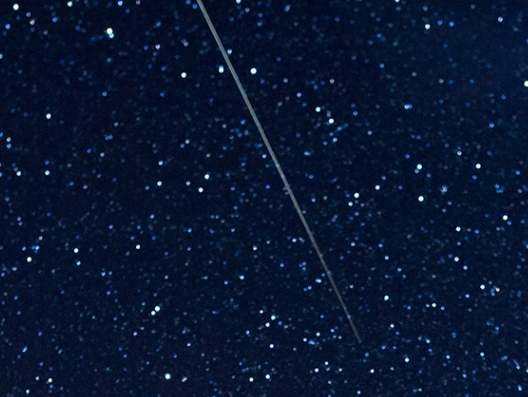Story Highlights
- The meteors are pieces of dust and ice from Halley's comet.
- These meteors are swift – traveling at about 148,000 mph into Earth's atmosphere.
- The greatest number of Eta Aquarid meteors should fall before dawn on Wednesday May 5.
The Eta Aquarid meteor shower is the first of two showers that occur each year as a result of Earth passing through dust released by Halley’s Comet. (Photo: NASA)
One of spring’s top skygazing events is coming next week: the Eta Aquarid meteor shower, which comes from the debris trail of the famed Halley’s comet.
This year, the forecast calls for the greatest number of Eta Aquarid meteors to fall before dawn on Wednesday, May 5, according to EarthSky.org.
“But don’t discount May 4 or 6, either or both of which might provide a good sprinkling of meteors, too,” EarthSky’s Bruce McClure said.
Eta Aquarid meteors, also called the Aquarids, are known for their speed, according to NASA. These meteors are swift – traveling at about 148,000 mph into Earth’s atmosphere. Fast meteors can leave glowing “trains” (bits of debris in the wake of the meteor) that last for several seconds to minutes.
The shower favors the Southern Hemisphere because the point in the sky where the meteors appear to come from is in the constellation Aquarius, which is higher in the sky in the Southern Hemisphere. However, folks in the Northern Hemisphere can still see and enjoy the shower, with some 10 meteors per hour expected at its peak.
In the Northern Hemisphere, Eta Aquarid meteors can more often be seen as “earthgrazers,” NASA said. Earthgrazers are long meteors that appear to skim the surface of the Earth at the horizon.
The Eta Aquarid is one of Earth’s two meteor showers that come from the debris trail of the famed Halley’s comet. The other is the Orionid meteor shower, which occurs each October.
The meteors are pieces of dust and ice from the comet.
Halley’s comet was discovered by Edmund Halley in 1705, but it is believed to have been recognized for millennia. NASA said the comet is featured in the Bayeux tapestry, an embroidered cloth that depicts the Battle of Hastings in 1066.
The comet itself can be seen from Earth about every 76 years, but the particles that create the Eta Aquarid shower were shed hundreds of years ago.
How to watch a meteor shower: Tips for the best viewing experience
If you’re a newbie when it comes to meteor showers, here are some tips from EarthSky:
►Give yourself at least an hour of viewing time for watching any meteor shower. Meteors tend to come in spurts that are interspersed by lulls. Also, it can take as long as 20 minutes for your eyes to adapt to the dark.
►Moonlight might somewhat hamper the viewing of the Eta Aquariid meteor shower this year, as well.
►You need no special equipment to watch a meteor shower, but a little luck always helps. Find a dark, open sky away from artificial lights, and sprawl out on a reclining lawn chair. Meteor watching is a lot like fishing. Sometimes you catch a good number of them, and sometimes you don’t, EarthSky said.
Contributing: Kimberly Miller, The Palm Beach Post
Source: Read Full Article

